SBI Balanced Advantage Fund: One of the top performing consistent balanced advantage funds

Current market context
The equity market is in a recovery phase after bottoming out in March 2025. However, bouts of volatility continued to impact the market due to geo-political factors e.g. Pahalgam terrorist attacks and Operation Sindoor, Israel Iran War etc. The market has rebounded after ceasefire was announced between Israel and Iran. However, there are lingering global trade uncertainties as the tariff pause announced by the Trump Administration is set to expire. Global macro-economic developments and central bank actions have driven asset prices across different asset classes to all-time highs e.g. US Equities (S&P 500), Gold, Silver etc., are at all-time highs. Though Indian equities are still below their all-time highs, the rally over the last 3 months has pulled up valuations.
Why you need have to disciplined investment approach?
Though informed investment decisions based on rational behaviour and discipline are essential for achieving our financial objectives, it is natural for humans to have behavioural biases. Behavioural factors e.g. greed and fear, herd mentality, loss aversion bias etc in volatile equity markets, can lead to wrong decisions and sub-optimal returns. These behavioural biases come to fore in uncertain market conditions. Instead of having a disciplined approach, many investors want to maximize their returns by timing the market. Timing the market involves crystal ball gazing, i.e. trying to predict how the market will behave in the short term, so the investors can time their entry and exit. Predicting the correct timing of entry and exit, is very difficult even for experts because prices in the short term are driven by sentiments, rather than fundamentals
Instead of trying to guess how the market will behave, you should have a disciplined investment approach based on an asset allocation. A 1986 study done in the United States showed that asset allocation is the most important determinant of portfolio performance (source: Brinson, Hood, Beebower, Financial Analyst Journal 1986). In this article, we will review SBI Balanced Advantage Fund which uses a disciplined asset allocation model based on market conditions.
About SBI Balanced Advantage Fund
Apart from conventional dynamic asset allocation factors like valuations and earnings drivers SBI Balanced Advantage Fund uses parameters like sentiment indicator to decide on asset allocation. This is taken basis various macro inputs like Fiscal / Monetary positions, real rates, monetary policy framework, variables of offshore markets etc. The fund aims to capture the potential upside and limit the downside of equity markets. The fund was launched in August 2021 and has given 12.15% CAGR returns since the inception of the fund.
SBI Balanced Advantage Fund
The fund has outperformed its peers across different periods (see the chart below)
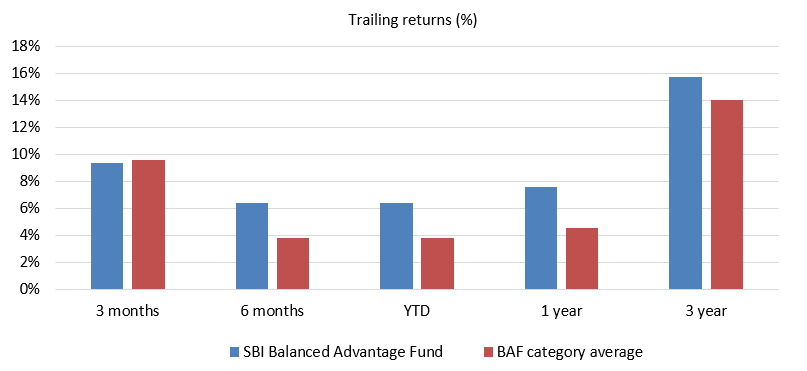
Source: Advisorkhoj Research, as on 07.07.2025
How SBI Balanced Advantage Fund performed versus traditional fixed income?
The chart below shows the growth of Rs. 10,000 lump sum investment in SBI Balanced Advantage Fund versus traditional fixed income savings like Government Small Savings Schemes. You can see that the SBI Balanced Advantage fund was able to provide significantly higher investment returns compared to Government Small Savings Schemes like PPF. That is why this fund is suitable for investors who want to enjoy the potential growth opportunities offered by equity markets while aiming to limit the downside.
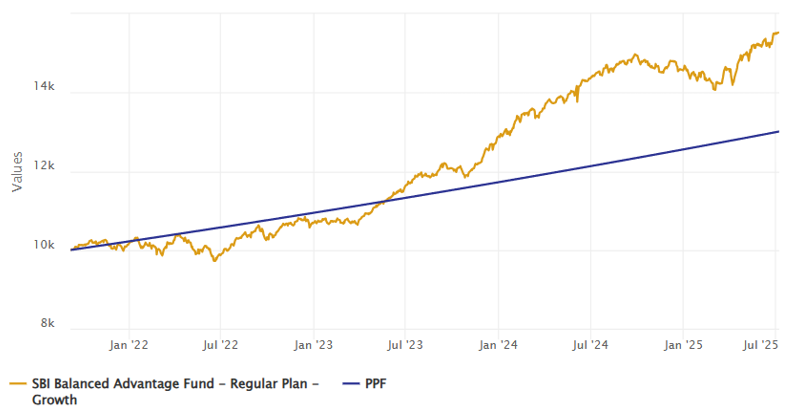
Source: Advisorkhoj Research, as on 07.07.2025. Disclaimer: The comparison of SBI Balanced Advantage Fund vs. PPF is given for information purposes only. Investment in SBI Balanced Advantage Fund carries high/very high risk, there is no guarantee of protection of capital in mutual funds and should not be construed as any assurance for future returns. Investors are advised to consult their tax/financial adviser, in view of individual nature of tax consequences, before taking any investment decision
Downside risk limitation
The chart below shows the drawdowns of SBI Balanced Advantage Fund versus the leading broad market index, Nifty 50 TRI. You can see that the fund was able to downside risk for investors compared to equity as an asset class, while providing reasonably higher returns compared to traditional fixed income.
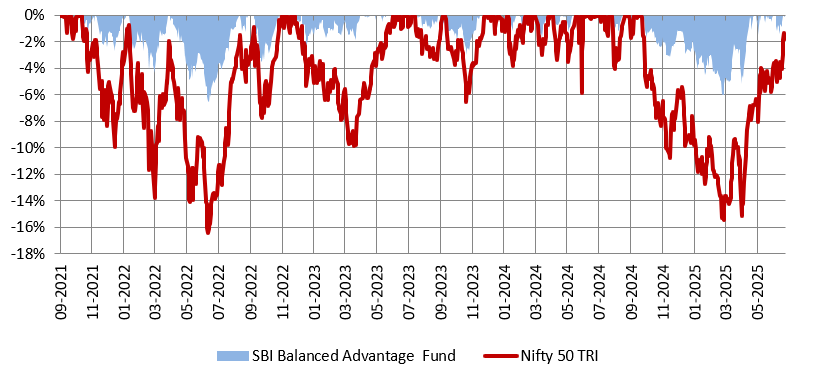
Source: Advisorkhoj Research, as on 30.06.2025
Asset allocation of the SBI Balanced Advantage Fund
- Net long Equity: This is the un-hedged equity exposure of the fund. Net equity allocation is determined by the fund managers, using parameters such as Sentiment Indicator, Valuations & Earnings Drivers. The net long-equity allocation of the scheme is aimed at providing long term capital appreciation (wealth creation) for investors and involves high conviction ideas of the fund manager and analyst team.
- Debt: Debt allocation is based on high credit / sovereign portfolio to maintain liquidity and provide stability in volatile markets.
- Arbitrage: This is the fully hedged equity component but generates arbitrage returns based on price differences in cash and futures market or corporate actions. The arbitrage component reduces the net long equity exposure and at the same time, helps to keep the gross equity exposure above 65%, and provide equity taxation benefits to investors.
Portfolio construction strategy
The scheme has a quantitative framework, the top-down investment strategy in terms of the market cap allocation, investment style (growth / value / quality), sector preference etc. Stock selection is based on the fund manager’s conviction. The fund manager uses portfolios based on the highest conviction ideas of the SBI MF analyst team. The debt portion of the scheme portfolio is of high credit quality / sovereign securities to maintain liquidity. The fund manager actively manages the duration to generate alpha across the yield curve.
SBI Balanced Advantage Fund outperformed peers across different market conditions
The chart below shows the 1-year rolling returns of SBI Balanced Advantage Fund versus the category average since inception. You can see that the scheme has consistently outperformed the category average across different market conditions over 1 year investment tenures since inception.

Source: Advisorkhoj Rolling Returns, as on 07.07.2025
The chart below shows the 1-year rolling returns distribution of the fund versus category average since the inception of the fund. You can see that the fund did not give negative returns over 1 year tenure (versus 3.8% average negative return instances for the category). The fund gave double digit returns in 62% instances (versus 49% instances for category average). Overall, the fund was able generate superior risk adjusted returns versus its peers.
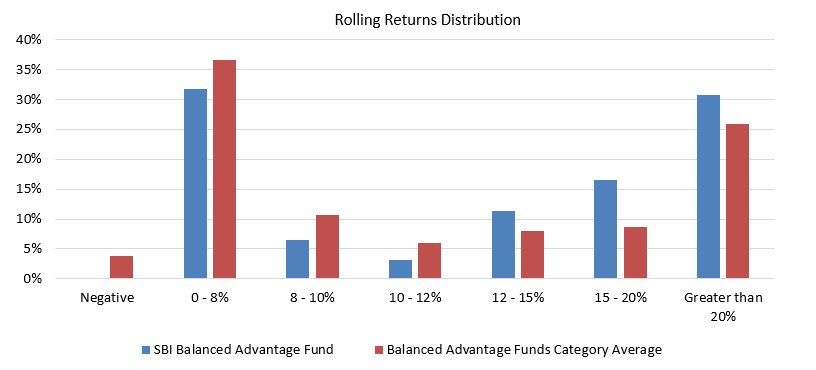
Source: Advisorkhoj Rolling Returns, as on 07.07.2025
Consistently in the upper quartiles
The graphic below shows the quarterly returns and the quartile rankings of the fund versus category average for the last 12 quarters. You can see that the fund was in the top 2 quartiles (in shades of green) 8 times in last 12 quarters. This shows the strong performance consistency of the fund.

Source: Advisorkhoj Research, as on 31.03.2025
Regular cash-flows through SWP
Since Balanced Advantage Funds are more stable than pure equity funds or aggressive hybrid funds, they are more suited for generating cash-flows through SWP over long investment tenures. The chart below shows the result of Rs 30,000 monthly SWP from Rs 50 lakhs lump sum investment in the SBI Balanced Advantage Fund since the inception of the scheme i.e. more than 7% withdrawal every year. You can see that, despite drawing cash-flows of nearly Rs 13.8 lakhs over the last 3 – 4 ears through SWP, the value of your balance units in the scheme would have grown from Rs 50 lakhs to nearly Rs 60 lakhs. The capital appreciation implies that in future, you can increase your withdrawals by a moderate amount to meet inflationary needs / expenses, without significantly impacting the principal amount invested. If the value of your balance units after SWP is more than your initial investment, then you can sustain your SWP for long periods of time. This example shows that SBI Balanced Advantage Fund is well suited for SWP for retired investors or investors who are planning for retirement in the near to medium term.
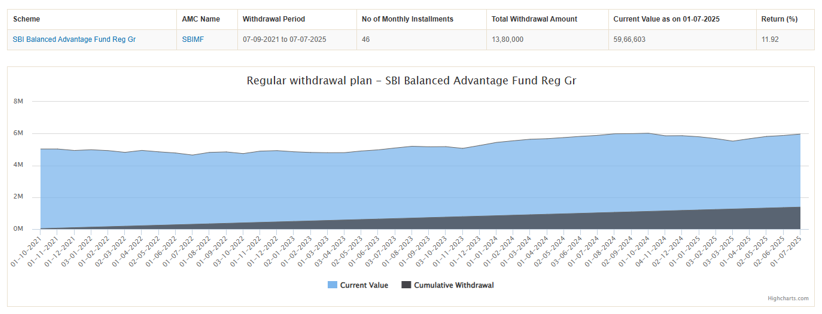
Source: Advisorkhoj SWP Calculator, as on 01.07.2025
Why invest in SBI Balanced Advantage Fund?
- For investors who would like to move between asset classes seamlessly and the decision is taken by an expert fund manager.
- The fund is suited for Investors wanting to benefit from both asset classes but would like to protect their investments from the downside potential of equity.
- Investors can invest in this fund as an asset allocation strategy i.e. to balance risks and returns.
- Investors who are close to retirement and do not want their retirement corpus exposed to vagaries of the equity market i.e. prefer relative stability vis-à-vis pure equity funds as well as growth potential to meet their retirement goal.
- Investors who have already retired and can do an SWP from this fund for tax efficient regular cash flow.
Who should invest in SBI Balanced Advantage Fund?
- Investors looking for long term risk adjusted returns.
- Investors looking for a solution for the optimal mix of debt and equity.
- Investors who do not have a high-risk appetite.
- Investors who have minimum 3 years of investment horizon.
Investors should consult with their financial advisors or mutual fund distributors if SBI Balanced Advantage Fund is suitable for their investment needs.
Mutual Fund Investments are subject to market risk, read all scheme related documents carefully.
RECOMMENDED READS
- Demystifying debt mutual funds
- Why Balanced Funds may be the best investments for new mutual fund investors
- How do you know if you have good funds in your mutual funds portfolio: part 1
- Know your mutual fund tax obligations to manage your investments effectively
- Asset Allocation is much more important than fund selection
LATEST ARTICLES
- SBI Dynamic Asset Allocation Active FOF: A smart asset allocation solution in shifting markets
- Your perfect Gift for your little ones this Childrens Day: SBI Magnum Childrens Benefit Fund Investment Plan One of the best performing funds for your childs future
- Magnum Hybrid Long Short Fund: A smart investment option in challenging conditions
- Delivering Returns with Resilience: SBI Multicap Funds proven multicap strategy
- SBI Equity Hybrid Fund: One of the top performing hybrid funds in current market conditions
Quick Links
Follow SBI MF
More About SBI MF
POST A QUERY





